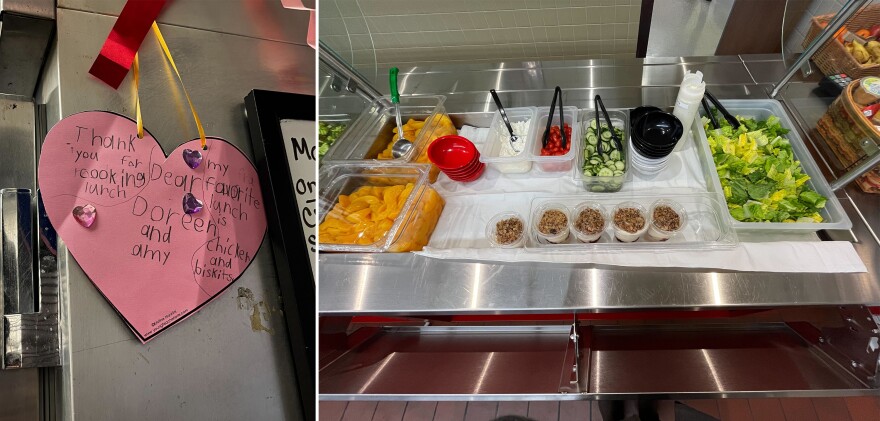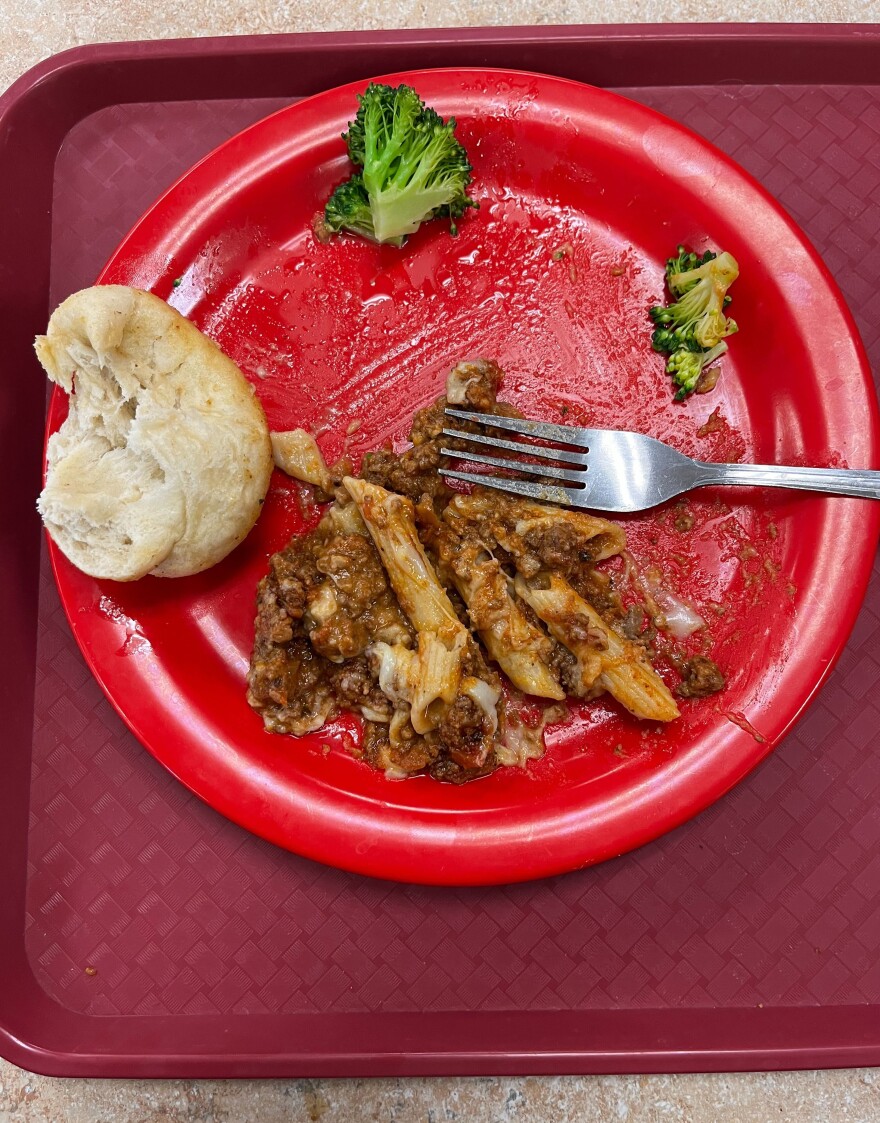Edorah Frazer has been the principal of Robinson Elementary School in Bristol, Vermont for eight years.
Each year there is one subject she always has to tackle: how to feed her 107 kids.
"When I first came into becoming a principal I was shocked by how much of my job had to do with food and not education," Frazer said. "If kids don't have access to food and if the food system isn't working, the kids are really limited in terms of their ability to learn."
Before the pandemic, about 45% of the students at Robinson qualified for either free or reduced-price meals. Parents had to fill out forms to determine if they were eligible and if not, it cost just over $2 a day for lunch.
Now, every student attending a public school in Vermont can get breakfast and lunch for free due to a pilot program.
"It used to be quite often when we were talking about kids who were displaying certain behaviors or who were having academic problems, that whether or not they had enough food was an element of that conversation," Frazer said. "And we just don't have that conversation anymore."
During the pandemic, every public school could offer free meals as a part of the financial assistance passed by Congress. For the 2022-2023 school year, that benefit ended which left schools grappling with record keeping and increasing student meal debt. Vermont is one of five states that created its own program to keep meals free.
More than a dozen states are considering some form of free school meal legislation in their statehouses. In the past two weeks, Minnesota and New Mexico joined Colorado in creating a permanent free school meals program. California and Maine had already established their own programs. Now, Vermont and New York hope to be next.
"States are stepping in because Congress has not acted," said Crystal FitzSimons, director of school and out-of-school time programs at the Food Research and Action Center. "In an ideal world, we would want every child in every school to have access to free breakfast and lunch. We think that kids in Alabama and Mississippi should be able to access free breakfast and lunch, just like kids in California and Colorado."
Most states lost free meals this school year
A majority of states in the country had to revert to the old method of handling meals this school year. Parents had to fill out forms to determine if they qualified for free or reduced-price meals. And lunch debt, or the money students owe the school for each meal that goes unpaid, is stacking up.
Just this year, for example, New Mexico is reporting $1.2 million in unpaid student debt.

"Schools are struggling to get kids certified for free or reduced-price school meals," FitzSimons said. "Some school districts are actually reporting higher denials for free and reduced-price school meals. So families who are struggling that thought they might qualify for free or reduced price meals find out that the eligibility threshold is actually too low."
For the upcoming 2023-2024 school year, a family of four cannot make more than $55,500 a year for reduced-price meals or $39,000 for free meals, according to the federal standards.
Administrators in Vermont fear if the state does not take any action this year, its schools will meet the same fate after the pilot program ends in the coming months.
"Meal costs have risen, equipment costs have risen. Everything's much more expensive," said Kathy Alexander, director of the food service cooperative in the Mt. Abraham Unified School District in Vermont, noting that even if families are earning more on paper the rising cost of groceries and living can price them out.

"If we end up going back to a paid meal system, what will happen is that our programs will be in huge financial jeopardy because we will be faced with huge unpaid debt," Alexander explained.
Others have concerns that students will lose access to what could be their only healthy meal during the day. Andy Haas, the building administrator at Bellows Falls Union High School, recalls the embarrassing process when students couldn't pay for their meal.
"We had to throw it out in front of the student and then provide them like a sun butter sandwich or a cheese sandwich. It's just ridiculous," Haas said. "I know teachers find ways to provide meals to students and, with universal meals, to know that every kid can eat is a plus."
And the return of an application process described as "invasive" adds yet another layer of cost and procedure challenging for even small schools.
"The sign up process itself asks people detailed information about their personal finances," Frazer, the elementary school principal, said. "And so some people are willing to answer those questions and some aren't. And even if they're willing sometimes there are literacy issues in filling out those forms."
A pathway to passage across the country looks different in each state
Advocates in Vermont are waiting on the state senate to give its final approval on the bill, which would mandate every public school provide free meals to students. Republican Gov. Phil Scott is largely expected to approve the bill because it is not funded by what he calls "regressive tax increases." Instead, it uses existing education funds that cover items like school buses and could utilize property taxes.
"The people of our state appreciate this being a state project," said Democratic state Sen. Bobby Starr. "More than if it was just another federal program that was given to them."
In New York, both chambers included $280 million to pay for universal meals in the state, but it was not included in Democratic Gov. Kathy Hochul's budget. Three-way negotiations are underway with a deadline for a final budget on April 1, though talks could continue beyond the deadline.
Over a dozen other states have similar bills introduced in their state legislatures. Wisconsin and Michigan's governors included funding for free meals in their budget requests, even though legislation has not progressed.
Connecticut has funded a program through the end of this year after temporary funding ran out mid-school year leading to families and schools pivoting from free meals to paid meals back to free. In the short time when free meals lapsed the state incurred over $140,000 in meal debt.
In Massachusetts, advocates are pushing for one more year.
Many want Congress and Biden to make changes, too
Agriculture Department officials say the department has some flexibility to expand a program that allows schools in low-income areas to provide free meals. Biden wants to make 9 million more children eligible for the national free and reduced-price meal program. More than 28 million kids receive school lunch per day. Of those, according to USDA, about 70% receive free or reduced-price meals.
USDA announced that it would begin a rulemaking process that would allow about 20,000 schools to be eligible to provide free meals — though it is unknown how many would opt into the program.
In his budget proposal to Congress, Biden asked for $15 billion over 10 years to expand the community eligibility program. But last year, Republicans opposed extending the free meal pandemic benefit, citing it as temporary assistance so it's unlikely it will make the final budget in a divided Congress
But just expansion of this program is not enough since schools may need to pay costs upfront. And since it's not consistent nationwide, there's confusion for families trying to figure out how to navigate the school year.
"Every summer I started to get calls and letters from families saying, are we going to have free meals this year? And the answer varied," Vermont elementary school principal Edorah Frazer said. "If our society can handle the food issue and ensure that kids will be fed, then we can get on with the education issue, which is what we're trying to do here as our primary function."
Copyright 2023 NPR. To see more, visit https://www.npr.org. 9(MDIxMDkyNjUxMDE0NDY1Njg1NzRiOTRiYQ000))






